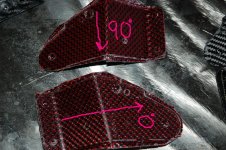Cracker Red
New member
Well, I've been lurking here for some time, reading about the amazing mythical feats of Tygaboy and his carbon.
So, I used to build CF wings for sailplanes a LONG time ago. Vac bagger was still in a box, along with a bunch of other stuff. Time to order up some cloth, and start tearing up perfectly good stock parts to try and make some bling:

Monster headlight mounts:


Monster heel gaurd:
I was in a hurry, didn't get the bubbles squeezed out. Failed attempt #1.

I havn't been using an PVA, and I'm wondering why there are some dry spots on my layups. Could it be because I'm so rusty I just forgot to use any PVA, and the wax is forcing out the resin?

One question for Chris if he's out there. The headlight brackets I copied are to flimsy....need another few layers really. Could I just lay them up again in the vac bagger? I don't see why not, but I figured I'd ask first.
Obviously all parts need to be sanded/cleared/polished. Not to bad for my first few attempts. Hopefully next time I use the PVA and I won't need to clear anything, just sport that satin "race-sheen" action.
So, I used to build CF wings for sailplanes a LONG time ago. Vac bagger was still in a box, along with a bunch of other stuff. Time to order up some cloth, and start tearing up perfectly good stock parts to try and make some bling:

Monster headlight mounts:


Monster heel gaurd:
I was in a hurry, didn't get the bubbles squeezed out. Failed attempt #1.

I havn't been using an PVA, and I'm wondering why there are some dry spots on my layups. Could it be because I'm so rusty I just forgot to use any PVA, and the wax is forcing out the resin?

One question for Chris if he's out there. The headlight brackets I copied are to flimsy....need another few layers really. Could I just lay them up again in the vac bagger? I don't see why not, but I figured I'd ask first.
Obviously all parts need to be sanded/cleared/polished. Not to bad for my first few attempts. Hopefully next time I use the PVA and I won't need to clear anything, just sport that satin "race-sheen" action.

 ... right on
... right on 